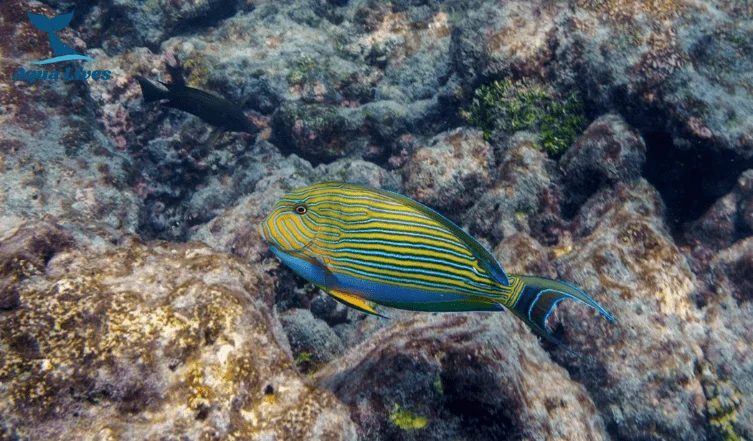Clown Tang a striking and popular saltwater fish known for their vibrant blue and yellow stripes. They are a favorite among aquarium enthusiasts because of their vivid colors and active nature. These fish add a lively and beautiful element to any marine aquarium, making them a sought-after choice for hobbyists looking to enhance their tanks.
The scientific name of the Clown Tang is Acanthurus lineatus.
Clown Tang Origin and Natural Habitat
These Tang are native to the Indo-Pacific region, including the waters of the Red Sea, East Africa, and the Great Barrier Reef. They thrive in coral reefs and lagoons, where they inhabit areas with plenty of live rock and coral formations. These environments provide them with ample hiding spots and grazing areas for feeding.
Appearance
- Body Shape and Size: Sleek, elongated body; can grow up to 15 inches long.
- Coloration: Vibrant blue and yellow stripes running horizontally along the body.
- Head Pattern: Distinctive dark blue bands on the head.
- Tail: Bright orange tail, adding to their striking appearance.
- Fins: Clear fins with hints of blue and yellow, complementing their overall color scheme.
- Eyes: Prominent eyes with a keen, alert look.
Male vs Female Clown Tang
- Physical Differences:
I have learned that Physical differences in Male and Female Tang is quite challanging and are not always reliable and can vary between individuals. - Behavioral Differences:
- Males are often more territorial and may display more aggressive behaviour in smaller tanks with other fish and even there similar spieces, especially during breeding. So they should me monitered when some tankmates are introduced.
- Females are generally more passive and may be seen schooling more often with other fish.
Clown Tang Tank Setup and Care
- Ideal Tank Size:
- Provide a tank of at least 180-200 gallons to accommodate their size and swimming needs, as they grow upto 15 inches long.
- Water Conditions:
- Temperature: Maintain a stable temperature between 72-78°F (22-26°C).
- pH: Keep the pH level between 8.1-8.4, reflecting their natural marine environment.
- Salinity: Maintain a specific gravity of 1.023-1.026 for optimal health.
- Hardness: Water hardness should be moderate to high.
- Substrate and Decoration Preferences:
- Use fine to medium-sized substrate to prevent injury to their delicate fins.
- Provide plenty of live rock with caves and crevices for hiding and grazing.
- Include artificial or live corals to mimic their natural reef habitat.
- Lighting and Filtration Requirements:
- Tangs doesnot particularly require a lighting requirment. Lighting should be tailored to the needs of the corals in the tank.
- Ensure efficient filtration to maintain water quality, as they are sensitive to fluctuations.
Clown Tang Diet
- Omnivorous Diet Details:
- Tangs require a balanced diet of plant and animal matter to thrive.
- They predominantly graze on algae and other marine vegetation in the wild, supplemented by small invertebrates.
- Recommended Food Types:
- Algae: Offer marine algae sheets or dried seaweed specifically for herbivorous fish.
- Meaty Foods: Include occasional feedings of high-quality frozen or live foods like brine shrimp or mysis shrimp. Overfeeding could cause health issues such as fatty liver disease.
- Prepared Foods: Use quality marine herbivore pellets or flakes to ensure a varied diet.
- Feeding Schedule and Tips:
- Feed small portions multiple times a day, replicating their natural grazing habits.
- Provide enough food that they can consume within a few minutes to prevent overfeeding and maintain water quality.
- Rotate food types to ensure nutritional diversity and health.
Behavior of Clown Tang
These fish exhibit a social nature and can coexist well with other non-aggressive tank mates of similar size in aquarium settings. They may display schooling behavior in large, open reef systems. In captivity, Its not the case as they establish territories within the tank. Due to their territorial tendencies, it’s essential to provide them with ample space and hiding spots to minimize aggression and potential conflicts with other fish. When selecting tank mates, it’s advisable to avoid aggressive or territorial species like other Surgeon fishes such as Blue Tang to maintain a harmonious environment for the fish and its tank mates.
Summary
Clown Tangs are a vibrant and active addition to any marine aquarium. Their striking blue and yellow stripes make them a standout choice for hobbyists. They thrive in spacious tanks with plenty of live rock and a balanced diet. While they can be territorial, providing ample hiding spots and choosing non-aggressive tank mates ensures a harmonious environment. With proper care, These tang can be a lively and beautiful presence in your aquarium.

